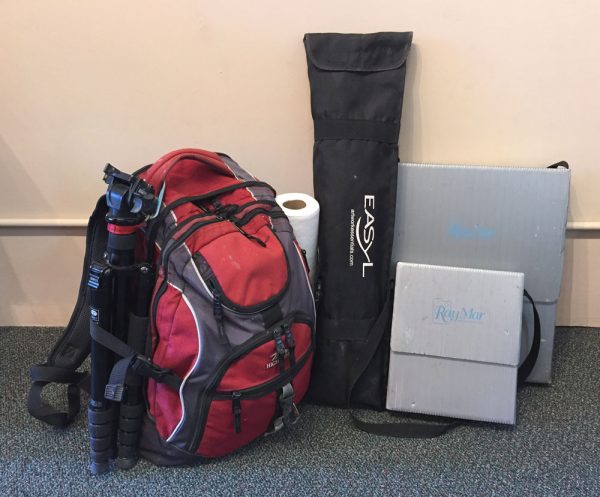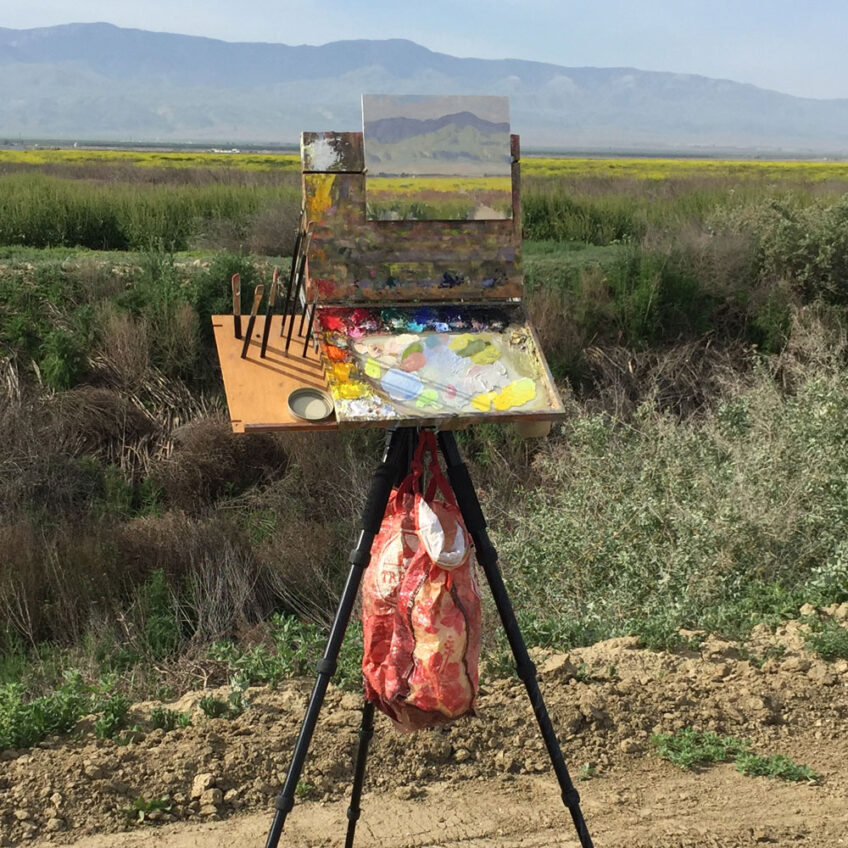I spend quite a bit of time painting outdoors (plein air) because I know how helpful it is to my process. (Read more about the benefits of plein air painting.) Perhaps you’re making an effort to paint outdoors more regularly yourself, but still aren’t sure what supplies to take along. If so, I’d like to share my plein air painting gear checklist with you.
I recommend limiting the number of supplies you use outdoors. Keeping your pack as light as possible is a definite plus, especially when hiking any significant distance. The idea is to bring only what you need. Try to leave things behind that you use only occasionally.

My Plein Air Painting Gear Checklist:
- Easel: I use an 11×14 pochade box made by Open Box M. (It’s a great-quality box — I’ve been using it since 2002, but unfortunately the company has now closed.) The pochade box mounts onto a Sirui T-2005X model tripod with a Manfrotto 3229 head. If you’re serious about limiting the weight of your setup, a pochade box will probably make the biggest difference.
- Canvas Panels: I recommend canvas panels rather than stretched canvas since light can’t shine through a panel from behind. Also, canvas panels are more portable and easier to store. If the canvas is mounted on a Gatorfoam panel, it’s also significantly lighter than a stretched canvas. Click here to learn how I make my canvas panels.
- Wet Panel Carrier: Especially if you’re painting with oil, you’ll need something to hold your wet painting while you carry it back to the car. I recommend the lightweight corrugated plastic wet panel carriers from RayMar. They sell a number of different sizes to accommodate small or large canvas panels. I use a 12” x 16” carrier with slots inside to accommodate multiple sizes.
- Brushes: I tend to use only 6 or 8 brushes for outdoor painting. Bringing fewer brushes of course means a little less weight. I also bring along a palette knife for cleaning my palette. Click here for more about my recommended brushes.
- Brush Carrier: A roll-up carrier or zipper case is great for protecting your brushes inside your pack.
- Paint: I usually use a palette of 10 – 12 oil colors, but sometimes limit my palette to 6 or so. Bringing fewer tubes of paint along also means a lighter pack. I prefer M. Graham & Co. oil colors.
- Brush Washing Container and Solvent: I use a small container with a lid that seals to hold my solvent for cleaning my brushes. I use Gamsol odorless mineral spirits. You can find a sealable brush washing container at an art supply store or possibly a hobby store.
- View Finder: A tool to help with composition can be helpful. I recommend the ViewCatcher.
- Umbrella: An umbrella can be great for shade in hot weather. The Easy-L Umbrella Kit has a great design that allows the umbrella to detach from its shaft in high wind so that your easel won’t blow over.
- Small Sketch Pad and Pencil: Useful for preliminary sketches and notes.
- Multi-Tool: I carry a Coleman multi-tool with pliers, screwdrivers, knives, etc. Pliers are helpful for stuck paint tube lids. Screwdrivers come in handy for easel maintenance.
- Paper Towels: I use Viva brand. The extra thickness compared to other brands means I don’t use as many.
- Trash Bag for Used Paper Towels: A reusable plastic-coated shopping bag works great and lasts a long time. I got mine at Trader Joe’s.
- Miscellaneous: It’s a good idea to wear a hat, bring along a rain jacket, sunscreen, insect repellant and drinking water.
- Backpack: To carry it all.
I’ve been using these products for many years and they continue to faithfully meet my needs. Recently I’ve received a few sample products from some of these art supply companies. But I recommend their products simply because they’ve proven to be worth recommending.
I hope this checklist will help you get outdoors to paint! Maybe it will lighten your load too. My gear weighs about 29 lbs. with everything included. If I limit the number of canvas panels, tubes of paint, etc., I can get it under 20 lbs. Not bad for hiking up a trail to find a great painting spot.

14 Responses
Keith
Dan,
I don’t paint but always find your blog interesting. Thanks for the quality articles.
Dan Schultz
Thanks for the nice comment, Keith!
Janine
Thank you, Dan! This is such a great guide. that I feel encouraged to get outside to paint!
Dan Schultz
Glad you found it helpful, Janine.
Paul
Dan,
Think I’ll give this a shot, time to venture out from my studio.
Many Thx
Katelyn
Dan, this post was so helpful for me as a new plein air painter!
Do you ever paint on primed hardboard without the glued canvas or know any folks that enjoy working on that kind of surface? Thanks!
Dan Schultz
Hi Katelyn,
I rarely have painted on primed board without canvas glued to it. But from what I understand, you can use gesso or oil primer to prime a raw board for painting. It’s recommended to prime all sides of the board to protect the inside from moisture. But perhaps another artist could give you better advice on this one. 🙂
Patty
Hello,
Thank you for your list, it really helps. I’ve been using a metal paint box and tripod but it makes it heavy. I’ve been looking for a lighter wood one.
Any tips for colder weather painting?
Dan Schultz
Hi Patty, I’m a fan of the Open Box M pochade box if you’re looking for a lighter easel setup. I wrote an article about the ones I have. It’s an older post, so I’ve updated my tripod since then, but maybe you’ll find the post helpful:
https://www.danschultzfineart.com/open-box-m-pochade-box-favorite-painting-equipment/
Also, I wrote a post about painting in snow in case you’ll find that helpful for cold weather:
https://www.danschultzfineart.com/five-tips-for-painting-snow-outdoors/
Andrew Huffman
Dan, going to venture out myself finally! Brand new plein airer here! Got a Meeden 11×14 pochade box, and go do a little Missouri scenery! What do you recommend for a jar to use for the cleaner?
Dan Schultz
Glad to hear it, Andrew. Something like this is portable and great for cleaning your brushes:
https://www.jerrysartarama.com/petite-air-tight-brush-washer
You can sometimes find similar containers at a hobby store like Michaels or Hobby Lobby.
Martina
Dan, do you use Liquin or something like that when you go outdoors? Or do you tend to tone the canvas before? I am newish in oils and acrylics (I am a pastellist), but got the gear now and looking forward to try plein air on my next trip to Italy!
Dan Schultz
Hi Martina, I don’t use Liquin at all. Just paint and Gamsol. And I usually tone the canvas on site (if I decide to tone it — sometimes I just paint on the white canvas). I would recommend trying a few paintings without toning, and a few with a tone and see how each feels and which you like better. Hope you have a great trip to Italy!
Richard Kearney
Excellent introduction on how to prepare for painting outdoors. Just wondering though, what your palette is. I always get mesmerised by all the colours I have. Then, when I paint I’m invariably reinventing the wheel.